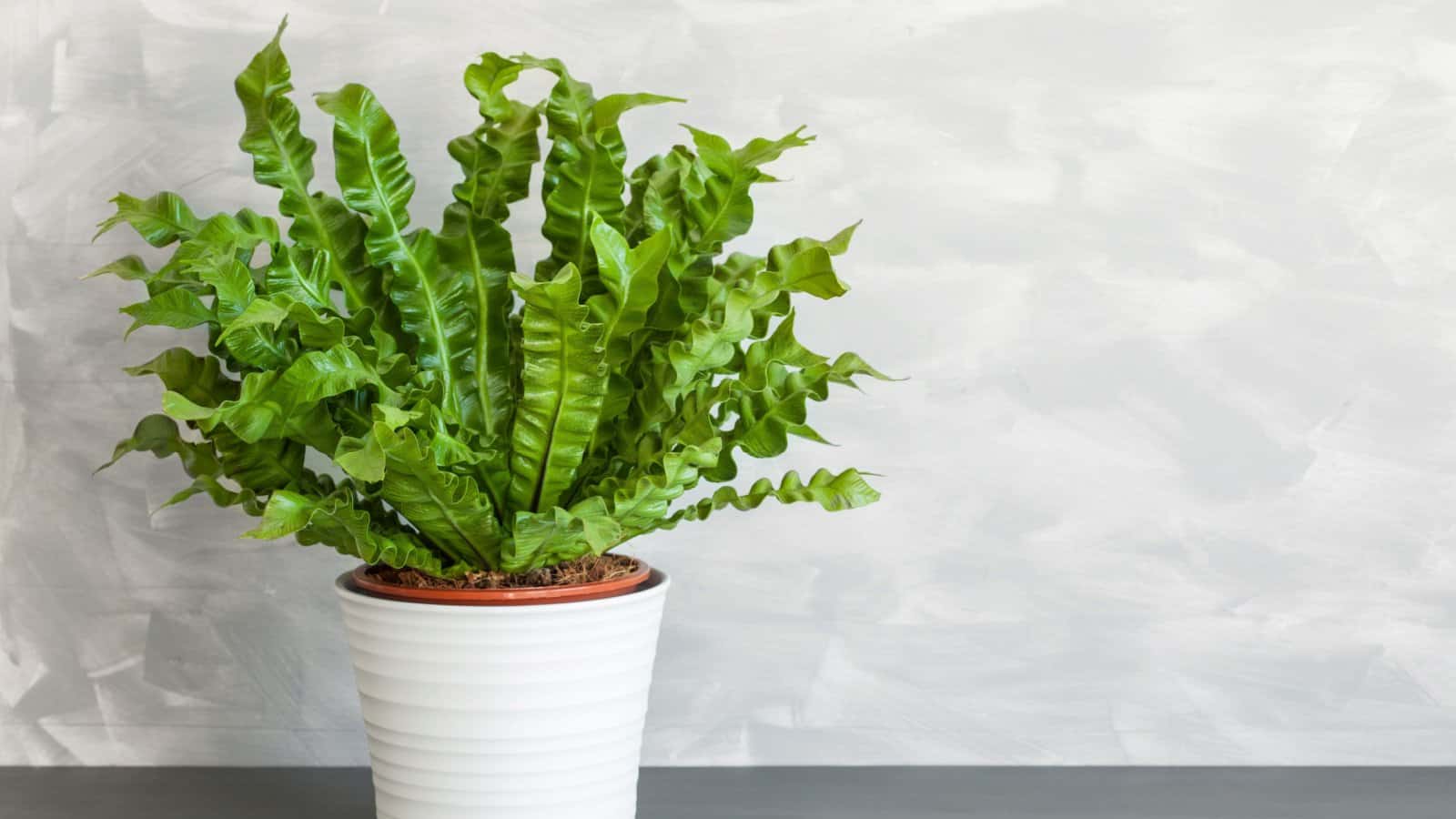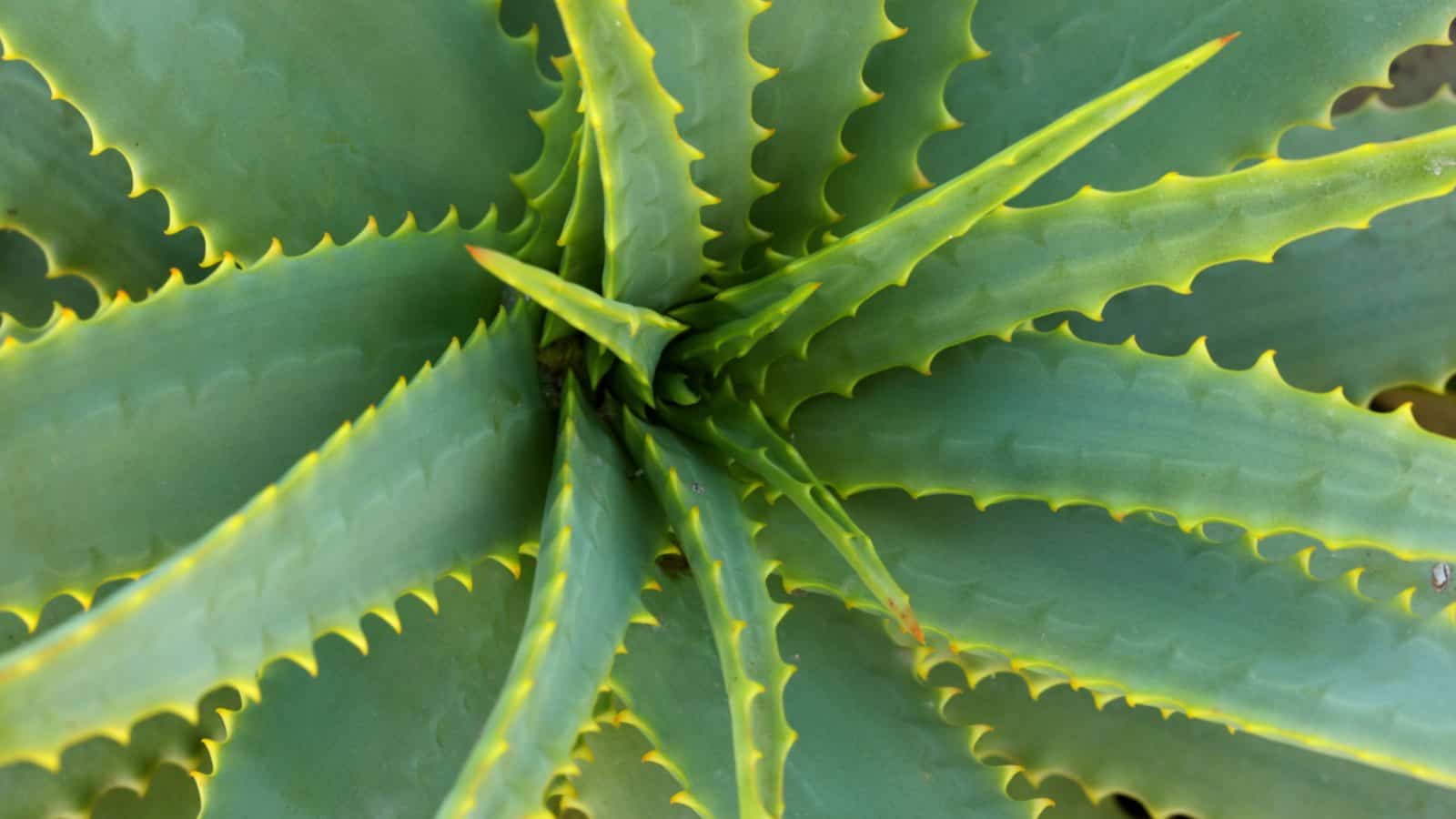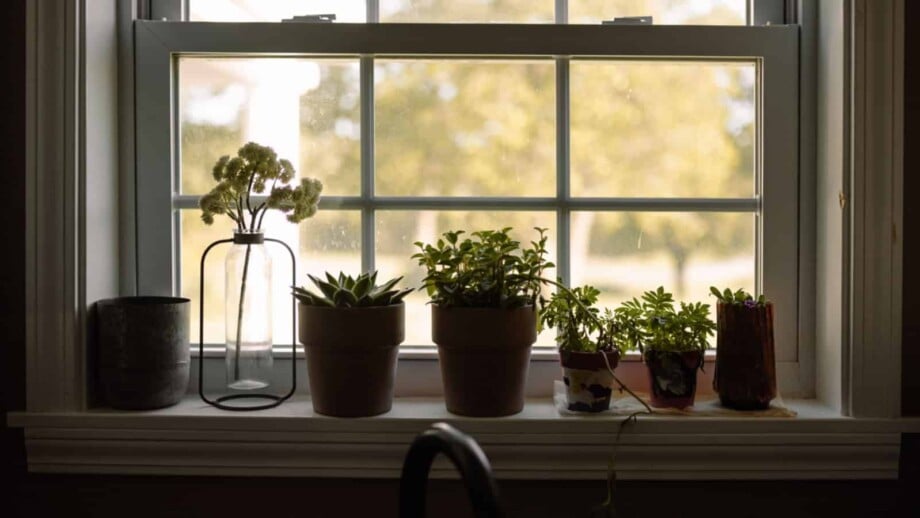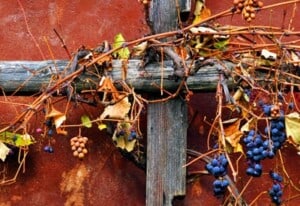Are you excited to infuse your interior with indoor plants, yet your space doesn’t receive enough sunlight? Fear not, for you are about to learn the top 34 low-light indoor plants to spread throughout your home.
In this article, you’ll journey through various low-light indoor plants suited to flourish under shade. You’ll answer questions like, “Do these plants need low or high humidity?” “Are dark green leaves always a good indicator of growth?” “What are the best light levels for indoor plants?” and even “Bright indirect light or direct sun?”
Watch as these resilient beauties, with their native charm and clusters of foliage, thrive in the embrace of muted sunlight. Let’s transform those dim pockets into a lavish indoor oasis where vines of life will flourish amid the enchanting dance of shadows!
1. Snake Plant (Sansevieria trifasciata)

- Light: Low to indirect light
- Size: 6 inches to 3 feet tall
- Difficulty: Easy
- Toxicity: Mildly toxic to pets
The Snake Plant (Sansevieria trifasciata), also known as Mother-in-law’s Tongue, is a hardy and popular succulent plant recognized for its striking appearance and low-maintenance requirements. Native to West Africa, it is characterized by its upright, sword-like leaves reaching 2-4 feet. The leaves feature a distinctive green coloration with yellow or white horizontal bands, giving it an eye-catching aesthetic.
One of the planet’s most remarkable attributes is its ability to thrive in various light conditions, from low to bright indirect light, making it an ideal choice for indoor environments. Additionally, Snake Plants are renowned for their air-purifying qualities as they efficiently remove toxins such as formaldehyde and benzene.
2. ZZ Plant (Zamioculcas zamiifolia)

- Light: Low to indirect light
- Size: Up to 3 feet tall
- Difficulty: Easy
- Toxicity: Mildly toxic if ingested
The ZZ Plant’s growth is relatively slow and can tolerate a wide range of light conditions, from low to bright indirect light. It can remove toxins such as xylene, toluene, and benzene from the air, contributing to its reputation as an air-purifying plant.
Propagation of the ZZ Plant can be accomplished through rhizome division, where individual rhizomes with roots are separated and replanted. The plant’s hardy nature makes it relatively resistant to pests and diseases, but overwatering should be avoided to prevent root rot.
3. Pothos (Epipremnum aureum)

- Light: Low to indirect light
- Size: Trail up to 10 feet
- Difficulty: Easy
- Toxicity: Mildly toxic if ingested
Native to Southeast Asia, Pothos, known as the devil’s ivy, is renowned for its versatility, ease of care, and air-purifying qualities. The plant’s heart-shaped leaves come in various color variations, including shades of green, yellow, and variegated combinations, contributing to its ornamental appeal.
Pothos is characterized by its ability to thrive in various light conditions, from low to bright indirect light, making it a popular choice for indoor environments. It has a vining growth habit and can be trained to climb or hang, making it suitable for both tabletops and hanging baskets.
4. Cast Iron Plant (Aspidistra elatior)

- Light: Low to indirect light
- Size: 2 to 3 feet tall
- Difficulty: Easy
- Toxicity: Non-toxic
The Cast Iron Plant, scientifically known as Aspidistra elatior, is a hardy evergreen perennial that belongs to the Asparagaceae family. Native to Eastern Asia, particularly Japan and China, this plant has earned its common name due to its incredible resilience and ability to tolerate challenging growing conditions.
The Cast Iron Plant is recognized for its robust and glossy dark green leaves that are lance-shaped and arise directly from the soil in a clumping manner. These leaves can grow quite long, often reaching up to 2 feet in length.
5. Chinese Evergreen (Aglaonema spp.)

- Light: Low to medium indirect light
- Size: Up to 3 feet tall
- Difficulty: Easy to moderate
- Toxicity: Mildly toxic if ingested
Chinese Evergreens typically have broad, lance-shaped leaves in various colors and patterns, including shades of green, silver, white, and pink. The plant’s ability to thrive in low light makes it suitable for interior spaces with limited natural sunlight.
Like other indoor plants, it is also known for its air-purifying qualities, as it can help remove toxins like formaldehyde and benzene from indoor air. Chinese Evergreens can be propagated through stem cuttings or by division, where the mature plant is divided into smaller sections, each with its roots and stems.
6. Dracaena (Dracaena spp.)

- Light: Low to medium indirect light
- Size: Varies by species
- Difficulty: Easy to moderate
- Toxicity: Toxic to pets
Dracaena plants can range from small tabletop varieties with rosette-like formations to taller, tree-like species with single or multiple trunks. Their leaves vary widely in appearance; some are long and strappy, while others are lance-shaped or even more intricate.
Leaf colors can include shades of green, variegated patterns, and combinations of red or purple. Some common Dracaena species include Dracaena marginata, Dracaena fragrans, and Dracaena reflexa.
7. Parlor Palm (Chamaedorea elegans)

- Light: Low to indirect light
- Size: 2 to 6 feet tall
- Difficulty: Easy
- Toxicity: Non-toxic
The Parlor Palm features thin, arching fronds from a central trunk-like stem. The fronds are composed of numerous leaflets and create a feathery appearance. This plant is well-suited for interior environments with limited natural light and can tolerate a range of light conditions, from low to bright indirect light. While it can thrive in low light, providing more brilliant light can help maintain healthier growth.
The Parlor Palm’s elegant appearance, adaptability to indoor conditions, and historical significance as an ornamental plant have contributed to its enduring popularity as a choice for interior landscapes.
8. Spider Plant (Chlorophytum comosum)

- Light: Low to medium indirect light
- Size: Up to 2 feet tall
- Difficulty: Easy
- Toxicity: Non-toxic
Native to South Africa, the Spider Plant is renowned for its distinctive arching leaves and its ability to produce offsets, or “pups,” that dangle down like spiders on a web, giving rise to its common name.
From a technical perspective, Spider Plants have long, narrow leaves, typically green with white or cream-colored stripes along the edges. These leaves can grow up to several feet in length and arch gracefully, creating an appealing cascading effect. One of the plant’s unique features is its ability to produce small plantlets at the ends of long stems, which can be easily propagated to create new plants.
9. Peace Lily (Spathiphyllum spp.)

- Light: Low to medium indirect light
- Size: 1 to 4 feet tall
- Difficulty: Moderate
- Toxicity: Mildly toxic if ingested
Native to the tropical regions of Central and South America, the Peace Lily is prized for its elegant white flowers and its ability to thrive in indoor environments with low light conditions.
From a technical perspective, Peace Lilies are characterized by their dark green, glossy leaves and distinctive white bracts surrounding the flowers. These bracts are often mistaken for petals and give the plant a visually appealing appearance.
10. Heartleaf Philodendron (Philodendron hederaceum)

- Light: Low to medium indirect light
- Size: Trail up to 10 feet
- Difficulty: Easy
- Toxicity: Mildly toxic if ingested
Heartleaf Philodendrons can be propagated through stem cuttings, where a section of stem with a few leaves is placed in water or soil to develop roots. Regular pruning can help maintain a neat appearance and encourage bushier growth.
This plant is relatively pest-resistant, but it’s still important to periodically inspect for common pests like spider mites or mealybugs. The Heartleaf Philodendron is generally considered safe for pets, although it’s always best to monitor plant-pet interactions.
11. Dieffenbachia (Dieffenbachia spp.)

- Light: Low to medium indirect light
- Size: Up to 4 feet tall
- Difficulty: Moderate
- Toxicity: Highly toxic if ingested
Dieffenbachia, commonly known as Dumb Cane, is a genus of flowering plants in the Araceae family, native to the tropical regions of Central and South America. Dieffenbachia plants have large, broad leaves in various patterns and colorations, often featuring green, white, and yellow combinations. The leaves are typically ovate or lance-shaped, and their size varies based on the specific cultivar.
Dumb Cane plants prefer bright, indirect light but can also tolerate lower light conditions, making them suitable for various indoor settings. Proper watering is essential to prevent overwatering and root rot; the soil should be allowed to dry out between waterings partially.
12. Bamboo Palm (Chamaedorea seifrizii)

- Light: Low to indirect light
- Size: Up to 7 feet tall
- Difficulty: Moderate
- Toxicity: Non-toxic
The Bamboo Palm, scientifically known as Chamaedorea seifrizii or Reed Palm, is a popular indoor palm plant that belongs to the Arecaceae family. Native to Mexico and Central America, this plant is known for its graceful and slender appearance, resembling the growth habit of Bamboo, and is often chosen for its ability to thrive in low-light conditions.
13. Rattlesnake Plant (Calathea lancifolia)

- Light: Low to medium indirect light
- Size: Up to 2.5 feet tall
- Difficulty: Moderate
- Toxicity: Non-toxic
The rattlesnake plant features long, lance-shaped leaves with intricate patterns of dark green spots and stripes on a lighter green background. The foliage is known to resemble the skin of a rattlesnake, hence its common name.
One of the fascinating aspects of the plant is its nyctinasty behavior, where the leaves fold up at night and unfold during the day—a response to changes in light levels.
14. Fiddle Leaf Fig (Ficus lyrata)

- Light: Low to medium indirect light
- Size: Up to 10 feet tall
- Difficulty: Moderate to high
- Toxicity: Mildly toxic to pets
The Fiddle Leaf Fig, scientifically known as Ficus lyrata, is a highly sought-after and visually striking indoor tree that belongs to the Moraceae family.
Native to western Africa, particularly Cameroon and Sierra Leone regions, the Fiddle Leaf Fig is renowned for its large, glossy leaves resembling a fiddle or violin.
15. Monstera (Monstera deliciosa)

- Light: Low to medium indirect light
- Size: Up to 10 feet tall
- Difficulty: Moderate
- Toxicity: Mildly toxic if ingested
Propagation of Monstera can be done through stem cuttings, where a section of stem with at least one node is placed in water or soil to develop roots. The aerial roots that often grow along the branch can also be used for propagation.
Monstera plants are relatively pest-resistant but should still be inspected for common issues.
16. Nerve Plant (Fittonia spp.)

- Light: Low to medium indirect light
- Size: Up to 6 inches tall
- Difficulty: Moderate
- Toxicity: Non-toxic
Due to their vibrant and distinctive appearance, Nerve Plants often add a pop of color and visual interest to homes and offices.
Nerve Plants are characterized by their small, ovate leaves with intricate veining patterns resembling nerves or veins. The veins can come in various colors, including white, pink, and red, contrasting with the green background of the leaves.
17. African Violet (Saintpaulia spp.)

- Light: Low to medium indirect light
- Size: Up to 6 inches tall
- Difficulty: Moderate
- Toxicity: Non-toxic
African Violets are characterized by their rosette-like clusters of fuzzy leaves and their colorful, often bi-colored, flowers in shades of purple, blue, pink, and white. The five-petaled flowers appear strikingly, with many cultivars boasting unique patterns and variations.
18. Maidenhair Fern (Adiantum spp.)

- Light: Low to medium indirect light
- Size: Up to 1 foot tall
- Difficulty: Moderate to high
- Toxicity: Non-toxic
Maidenhair Ferns are characterized by their delicate, fan-shaped fronds composed of numerous tiny leaflets, giving them a lacy and airy appearance.
The fronds can be pretty sensitive and are often associated with drooping when the plant is stressed or needs water.
19. Staghorn Fern (Platycerium spp.)

- Light: Low to medium indirect light
- Size: Varies by species
- Difficulty: Moderate
- Toxicity: Non-toxic
Staghorn Ferns are renowned for their two types of fronds: the shield fronds and the antler fronds. The shield fronds are basal and flat, resembling a protective shield that anchors the plant to its host tree or surface. On the other hand, the antler fronds are branched and arching, resembling the antlers of a stag, which gives the fern its common name.
20. Lucky Bamboo (Dracaena sanderiana)

- Light: Low to indirect light
- Size: Up to 3 feet tall
- Difficulty: Easy
- Toxicity: Mildly toxic if ingested
Lucky Bamboo is often associated with Feng Shui and is believed to bring positive energy, luck, and prosperity to its surroundings. The number of stalks in a Lucky Bamboo arrangement is thought to have specific meanings: for example, three stalks symbolize happiness, wealth, and longevity, while eight stalks are associated with growth and abundance.
21. Bird’s Nest Fern (Asplenium nidus)

- Light: Low to medium indirect light
- Size: Up to 2 feet tall
- Difficulty: Moderate
- Toxicity: Non-toxic
Maintaining higher humidity is crucial for Bird’s Nest Ferns, as they are native to humid forest environments. Dry air can lead to browning or crispy frond tips. Misting, using a humidity tray, or placing the fern in a more humid location can help create a suitable environment.
Propagation of Bird’s Nest Ferns can be done through division, where the plant is carefully separated into smaller sections, each with its roots and fronds.
22. Calathea (Calathea spp.)

- Light: Low to medium indirect light
- Size: Varies by species
- Difficulty: Moderate
- Toxicity: Non-toxic
Calathea plants are characterized by broad, ovate leaves that often feature striking patterns, colors, and textures. Some common Calathea species include Calathea orbifolia, Calathea lancifolia (Rattlesnake Plant), Calathea medallion, and Calathea zebrina (Zebra Plant). The leaves often exhibit shades of green, along with intricate patterns of stripes, spots, or veins that can be white, pink, red, or other contrasting colors.
Calathea plants are known for their unique behavior called “nyctinasty,” where the leaves fold up at night and open during the day.
23. Peperomia (Peperomia spp.)

- Light: Low to medium indirect light
- Size: Varies by species
- Difficulty: Easy to moderate
- Toxicity: Non-toxic
Peperomia plants are characterized by their succulent-like leaves that come in various shapes, colors, and textures. The leaves can be round, heart-shaped, lance-shaped, or even resemble watermelon rinds.
Some common Peperomia species include Peperomia obtusifolia (Baby Rubber Plant), Peperomia caperata (Emerald Ripple Peperomia), and Peperomia argyreia (Watermelon Peperomia).
24. Begonia (Begonia spp.)

- Light: Low to medium indirect light
- Size: Varies by species
- Difficulty: Moderate
- Toxicity: Mildly toxic if ingested
Begonias can be categorized into different types based on their growth habits, such as fibrous-rooted, tuberous, rhizomatous, and Rex Begonias.
Fibrous-rooted Begonias are often grown as bedding plants or in containers, while tuberous Begonias produce large, showy flowers and are commonly used as annuals. Rhizomatous Begonias spread through underground stems and are known for their unique leaf shapes and patterns. Rex Begonias are grown for their stunning foliage with intricate markings.
25. Rex Begonia (Begonia rex-cultorum)

- Light: Low to medium indirect light
- Size: Up to 1 foot tall
- Difficulty: Moderate
- Toxicity: Mildly toxic if ingested
Rex Begonias are characterized by their large, showy leaves that come in various shapes, sizes, and colors. The leaves are often deeply lobed, with intricate veining and patterns ranging from silver and green to deep burgundy and pink. The texture of the leaves can be smooth, velvety, or even slightly rough, adding to their visual appeal.
26. Neanthe Bella Palm (Chamaedorea elegans)

Neanthe Bella Palm features thin, arching fronds with pinnate leaves composed of multiple leaflets. The fronds are typically dark green and can grow in clusters from the base of the plant, creating a graceful and lush display. This plant is often grown in groups to enhance its fullness and aesthetic appeal.
- Light: Low to indirect light
- Size: Up to 6 feet tall
- Difficulty: Easy
- Toxicity: Non-toxic
27. Aloe Vera (Aloe barbadensis Miller)

- Light: Low to indirect light
- Size: Up to 1 foot tall
- Difficulty: Easy
- Toxicity: Mildly toxic if ingested
Aloe vera is a well-known succulent plant with a long history of medicinal and cosmetic use. Scientifically known as Aloe barbadensis Miller, it belongs to the Asphodelaceae family.
Native to arid regions of North Africa, the Canary Islands, and the Arabian Peninsula, Aloe vera is highly valued for its soothing gel and its adaptability as an indoor and outdoor plant.
28. Jade Plant (Crassula ovata)

- Light: Low to indirect light
- Size: Up to 3 feet tall
- Difficulty: Easy
- Toxicity: Mildly toxic if ingested
Jade Plant features thick, oval-shaped leaves that are typically jade green. The leaves store water, allowing the plant to withstand periods of drought.
Older Jade Plants may develop a woody stem; in favorable conditions, they can produce small star-shaped pink or white flowers.
29. Lipstick Plant (Aeschynanthus spp.)

- Light: Low to medium indirect light
- Size: Trail up to 2 feet
- Difficulty: Moderate
- Toxicity: Non-toxic
Lipstick Plant features dark green, glossy leaves and tubular, red or orange flowers that resemble lipstick tubes, hence its common name. The flowers emerge from the ends of trailing stems, creating a stunning visual display. The plant’s vining nature makes it suitable for hanging baskets or allowing it to cascade from elevated surfaces.
30. Zebra Plant (Aphelandra spp.)

- Light: Low to medium indirect light
- Size: Up to 2 feet tall
- Difficulty: Moderate
- Toxicity: Non-toxic
The Zebra Plant features large, lance-shaped leaves with contrasting green and white stripes that resemble zebra stripes, giving the plant its common name. The leaves are glossy and create an eye-catching display. The Zebra Plant is primarily grown for its foliage, although it also produces attractive, tubular yellow flowers that emerge from bracts.
31. Swiss Cheese Plant (Monstera adansonii)

- Light: Low to medium light
- Size: Trail up to 10 feet
- Difficulty: Moderate
- Toxicity: Mildly toxic if ingested
Swiss Cheese Plant features large, heart-shaped leaves that develop distinctive holes and splits as the plant matures, creating a visually striking pattern. The fenestrations are thought to be an adaptation to allow the leaves to withstand wind and heavy rainfall in their native environment. The plant can be vining in nature, making it suitable for training to climb or allowing it to trail.
32. Christmas Cactus (Schlumbergera spp.)

- Light: Low to indirect light
- Size: Up to 1 foot tall
- Difficulty: Easy
- Toxicity: Non-toxic
Christmas Cactus features flat, segmented stems with scalloped edges, creating a cascading or trailing growth habit. The plant’s flowers come in various colors, including shades of pink, red, white, and even lavender. The flowers are usually tubular and dangle from the stem segments, creating an elegant and eye-catching display.
33. Hoya (Hoya spp.)

- Light: Low to medium indirect light
- Size: Trail up to several feet
- Difficulty: Easy to moderate
- Toxicity: Mildly toxic if ingested
Hoya, commonly known as the Wax Plant or Wax Flower, is a genus of tropical succulent vines and shrubs renowned for their waxy, often fragrant flowers and attractive foliage.
Hoyas are characterized by their thick, leathery leaves and clusters of star-shaped flowers. The flowers, which can be of various colors, including white, pink, red, and even orange, often have a waxy texture and produce a sweet fragrance that becomes more pronounced in the evening.
34. Peacock Plant (Calathea makoyana)

- Light: Low to medium indirect light
- Size: Up to 2 feet tall
- Difficulty: Moderate
- Toxicity: Non-toxic
The Peacock Plant features large, ovate leaves with intricate patterns of dark green and lighter green that resemble peacock feathers, earning the plant its common name. The undersides of the leaves often have a reddish-purple hue. The leaves are slightly wavy and undulating, enhancing their visual appeal.
Peacock Plants prefer bright, indirect light but can tolerate lower light conditions as well. They should be protected from direct sunlight, which can cause their colors to fade.
Whether displayed individually or as part of a collection of foliage plants, Peacock Plants are sought-after options for plant enthusiasts looking to showcase unique and visually striking specimens.
Importance of Choosing Low-Light Indoor Plants
Choosing low-light indoor plants for your living space has numerous benefits. They can enhance the overall décor and provide a sense of freshness, tranquility, and well-being in areas that lack natural sunlight.
Notably, these indoor plants require less effort to maintain than their sun-loving counterparts. It saves homeowners from worrying about finding bright spots for sun-drenched greenery.
Low-light indoor plants have an inherent ability to adapt to darker spaces with minimal sunlight exposure. Varieties like the easy-care ZZ plant or the snake plant are renowned for their resilience under challenging growing conditions.

This versatility makes them suitable for windowless offices or rooms with north-facing windows where most other houseplants struggle to survive.
Furthermore, these plants don’t just add aesthetic value but also prove beneficial in improving indoor air quality by adding humidity and removing toxins from the environment. For instance, Snake Plants notably help filter out chemicals like benzene and formaldehyde from the air inside homes or offices.
Moreover, according to Feng Shui practice, certain species of low-light houseplants, such as Lucky Bamboo, can bring chlorophyll, good luck, and fortune into your home.
As such, opting for low-light varieties opens up new possibilities for those longing to diversify their indoor greeneries within darker spaces without compromising aesthetics or maintenance requirements.
Some of your home’s best low-light indoor plants include Lucky Bamboo, Spider Plant, Golden Pothos, Snake Plant, and English Ivy.
Classifications of Indoor Plants
From this diverse collection of indoor plants, let’s delve deeper and categorize them to offer you a more decadent array of choices. Within this section, I’ve highlighted which plants among the ones above stand tall, which are petite, those that demand minimal attention, and the ones perfect for suspending in a hanging basket.
Tall Plants

- Cast Iron Plant (Aspidistra elatior)
- Chinese Evergreen (Aglaonema spp.)
- Dracaena (Dracaena spp.)
- Parlor Palm (Chamaedorea elegans)
- Fiddle Leaf Fig (Ficus lyrata)
- Monstera (Monstera deliciosa)
- Staghorn Fern (Platycerium spp.)
- Neanthe Bella Palm (Chamaedorea elegans)
- Jade Plant (Crassula ovata)
- Christmas Cactus (Schlumbergera spp.)
- Hoya (Hoya spp.)
- Peacock Plant (Calathea makoyana)
Small Plants

- Nerve Plant (Fittonia spp.)
- African Violet (Saintpaulia spp.)
- Maidenhair Fern (Adiantum spp.)
- Bird’s Nest Fern (Asplenium nidus)
- Swiss Cheese Plant (Monstera adansonii)
- Lipstick Plant (Aeschynanthus spp.)
- Zebra Plant (Aphelandra spp.)
Easy to Care

- Snake Plant (Sansevieria trifasciata)
- ZZ Plant (Zamioculcas zamiifolia)
- Pothos (Epipremnum aureum)
- Cast Iron Plant (Aspidistra elatior)
- Chinese Evergreen (Aglaonema spp.)
- Parlor Palm (Chamaedorea elegans)
- Spider Plant (Chlorophytum comosum)
- Heartleaf Philodendron (Philodendron hederaceum)
- Lucky Bamboo (Dracaena sanderiana)
- Neanthe Bella Palm (Chamaedorea elegans)
- Aloe Vera (Aloe barbadensis Miller)
- Christmas Cactus (Schlumbergera spp.)
- Peacock Plant (Calathea makoyana)
Hanging Plants

- Pothos (Epipremnum aureum)
- Heartleaf Philodendron (Philodendron hederaceum)
- Swiss Cheese Plant (Monstera adansonii)
- Hoya (Hoya spp.)
How to Care for Low-Light Indoor Plants
To care for low-light indoor plants, you should water them sparingly and allow the soil to dry out slightly between watering.
Watering Practices
Proper watering ensures the health and growth of low-light indoor plants. Overwatering can induce root rot, which is harmful to your houseplants. Therefore, it’s crucial you let the soil dry out between waterings.

Various factors, such as humidity and specific plant needs, will influence watering frequency. Using a tray or saucer to water the plants from the bottom can prevent excess moisture, protecting your philodendron, pothos, ZZ plant, palms, ferns, and other low light-loving varieties from overhydration issues.
This method also avoids leaf burn due to direct application on foliage. Accurate watering practices promote flourishing greenery even in low-light conditions for easy-care houseplants.
Soil and Fertilizer
Low-light indoor plants require well-draining soil to prevent root rot. A potting mix specifically formulated for indoor plants can provide nutrients and moisture retention.

A good quality potting mix for low-light indoor plants should contain organic matter, perlite, and vermiculite. Garden soil or heavy clay-based soil should be avoided for these plants.
Low-light indoor plants should be fertilized sparingly due to their slower growth rates.
Temperature and Humidity
Low-light indoor plants thrive in temperatures ranging from 60-75°F (15-24°C). It’s crucial to avoid placing these plants near drafts or rooms with extreme temperature fluctuations, as they are sensitive to temperature changes.

Low-light plants can tolerate levels between 40-60% in terms of humidity. However, higher humidity levels can benefit their growth. To increase humidity for your low-light plants, you can mist the leaves occasionally or place them on a tray of water-filled pebbles.
Some plants, like ferns, may appreciate additional humidity boosts through misting or being placed in a bathroom or kitchen.
Low Light Indoor Plants and Health Benefits
Low-light indoor plants add beauty to your home and offer numerous health benefits. These plants purify the air by filtering toxins and releasing oxygen.
Lucky Bamboo, spider plants, and snake plants are particularly effective at removing harmful substances like formaldehyde and benzene from the air. In addition to improving air quality, low-light indoor plants can also help reduce stress levels and boost mood.
Studies have shown that being around nature calms the mind, promoting relaxation and mental well-being. So go ahead and bring some greenery into your home – your health will thank you!

Another advantage of low-light indoor plants is their ability to improve humidity levels in dry environments. Certain types of houseplants release moisture through transpiration, increasing the humidity in a room naturally without the need for expensive humidifiers.
This can benefit those who live in arid climates or spend long hours in air-conditioned or heated spaces.
Additionally, having low-light indoor plants has been linked to increased productivity and focus. Research suggests that having natural elements such as plants in an office or workspace can enhance cognitive function and concentration, improving work performance.

Overall, incorporating low-light indoor plants into your space enhances its aesthetic appeal and provides numerous health benefits ranging from cleaner air to reduced stress levels.
So why not bring some life into your home with these beautiful green companions?
FAQs
How often should I water my low-light indoor plants?
Low-light indoor plants require less water than full-sun plants because they have slower growth rates and evaporation. The watering frequency will depend on the specific plant, but it is generally recommended to water low-light indoor plants every two weeks or when the top inch of soil feels dry to the touch.
Overwatering can lead to root rot, so allowing the soil to dry out between waterings is essential. It’s always better to underwater than overwater these plants as they are more tolerant of drought conditions.
Remember, each plant has unique water needs, so it’s a good idea to observe your plant closely and adjust your watering schedule accordingly.
What type of soil is best for low-light indoor plants?
Low-light indoor plants thrive in soil that is consistently slightly moist. The best soil type for these plants is well-draining and rich in organic matter. It’s important to avoid heavy clay-based soils, as they can retain too much water and lead to root issues.
A recommended soil mix for low-light indoor plants includes potting soil, peat moss, and perlite or vermiculite. Adding organic matter such as compost or leaf mold can further improve the fertility and moisture retention of the soil, helping your low-light indoor plants flourish.
Can low-light indoor plants survive in artificial light?
Low-light indoor plants can indeed survive in artificial light. Plants like lucky Bamboo, spider plants, golden pothos, snake plants, staghorn ferns, English ivy, cast iron plants, peace lilies, maidenhair ferns, ZZ plants, philodendrons, anthuriums,.
Chinese evergreen and Swiss cheese plants are well-suited for low-light conditions in offices and homes. These plants can thrive even without natural sunlight. It is vital to place them in areas with indirect light and away from direct sunlight to ensure their growth and health.
Some varieties of low-light indoor plants require very little maintenance, such as English ivy and snake plants.
Conclusions
Transform your home or office into a lush indoor oasis with low-light plants. From lucky Bamboo to spider plants, there is a wide variety of options to choose from. With their ability to thrive in limited sunlight and low maintenance requirements, these plants are perfect for anyone looking to add greenery and life to even the darkest corners of their space.
Start creating your indoor garden today!
Other Houseplant Guides from Planet Natural:
26 Common House Plants That Are Perfect for Every Home
How to Grow and Care for Air Plants (No Soil Required)











